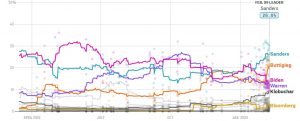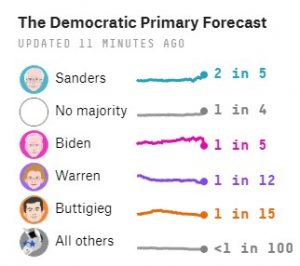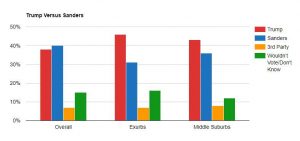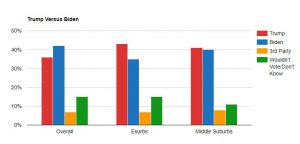In his article, “Trump’s Biggest Vulnerability” His lies about health care at the State of the Union signal just how weak he is on the issue” at The Atlantic, Ronald Browstein writes, “he repeatedly lied about his administration’s unrelenting efforts to gut the Affordable Care Act. To Democrats, Trump’s determination to surround his health-care record with what Winston Churchill once called a “bodyguard of lies” clearly signaled that the president recognizes how vulnerable his record could prove this fall…Because people see health care as so central to both their personal well-being and their financial well-being, health care stands out as Trump’s No. 1 vulnerability,” says the longtime Democratic pollster Geoff Garin. “The simplest way for people to understand the Trump economy is that whatever wage increases they are getting are smaller than the increases in their health-care premiums and out-of-pocket health-care costs.”
Brownstein continues, In an Associated Press/National Opinion Research Center survey last month, just 38 percent of Americans said they approved of his record on health care—a grade that has stayed relatively stable since he took office—compared with 56 percent who approved of his handling of the economy, the highest of his presidency…The latest monthly health-care poll from the Kaiser Family Foundation drilled down further into those views. In the survey, just about a third of adults gave Trump positive marks for dealing with preexisting conditions, the ACA, and prescription-drug costs. Detailed results provided to me by Kaiser showed that two key groups of swing voters shared this deep skepticism of Trump’s health-care record. A majority of college-educated white men disapproved of how Trump has handled each of the three issues. And while white women without a college degree—a group that could decide the Rust Belt states that tilted the 2016 election to Trump—broke against him more narrowly on the ACA and preexisting conditions, just 31 percent of them gave him positive marks on prescription-drug costs.”
“The Republican pollster Gene Ulm told me,” Brownstein notes, “that easing those doubts about his handling of health-care issues is crucial for Trump’s reelection prospects. “No president would be in the game without people believing the economy is getting better than it was,” Ulm said. But for “the next cluster of voters” beyond those immediately drawn to him, “it’s the cost of health care, prescription drugs, and the whole cluster of premiums, co-pays, [and] out-of-pocket expenses” that matter most…And on those fronts, the best measure of Trump’s anxiety was his mendacity in describing his record on Tuesday night…Trump, not for the first time, flatly lied about his efforts to revoke the ACA’s protections for those with preexisting conditions. Not only is his administration currently in federal court seeking to invalidate the entire ACA, but in 2017 he endorsed Republican proposals in Congress to effectively erase those protections by allowing insurance companies to charge people who have greater health needs more. “It’s notable that the president feels the need to say he’s protecting people with preexisting conditions,” Levitt says, “but the facts just don’t back that up.”
“Trump has talked about confronting prescription-drug costs since his 2016 campaign,” Brownstein adds, “when he embraced the long-standing Democratic idea of allowing Medicare to negotiate for lower prices with drug companies. But amid opposition from the pharmaceutical industry, and Republicans leery of an aggressive federal role in health care, he renounced that proposal…Democrats, meanwhile, have picked up the mantle, putting it at the center of the H.R. 3 legislation that the House passed in December. (That was the bill House Democrats were alluding to when a group of them rose to chant “H.R. 3” during Trump’s State of the Union address.)..The GOP-led Senate hasn’t taken up the bill, but the public’s intense focus on drug costs makes it possible that Trump will offer some proposals on the issue before Election Day. That’s why it’s so essential for Democrats to more sharply define the terms of debate right now. “It is really important for Democrats to set the bar on the drug-pricing issue at whether someone supports or opposes giving Medicare the power to negotiate,” Garin warns.”
“Trump’s religious supporters, most of whom preach the most conservative versions of Christianity, either don’t realize or don’t care that they are ratifying what so many young people have come to believe about religion: that it is nothing but a cover for conservative politics,” E. J. Dionne, Jr. writes in his syndicated Washington Post column, “Political idolatry is the enemy of religious faith.” Dionne adds that “it is far more about identity than faith, that it upholds a static traditionalism rather than a living tradition…Thus do 4 in 10 Americans under 40 declare that they have no religious affiliation whatsoever. They are far from devoid of profound moral commitments, and some of them still think of themselves as spiritual. But organized religion just doesn’t speak to them anymore…I acknowledge you have every right to be suspicious that I’m as inclined as anyone to see faith as blessing my own politics. Nonetheless, Romney showed us how religion is most usefully invoked in public life: when it prompts self-doubt rather than self-celebration, when it encourages us to build solidarity with those unlike us and when it promotes dissent rather than conformity.”
So, given the current political landscape, “Was Impeachment a Mistake?” Robert Kuttner, co-editor of The American Prospect addresses the question: “There is no evidence that the impeachment will hurt Democrats in November, and some evidence that it helped. During the entire investigation, polls scarcely moved. To the extent that public opinion shifted at all, it moved very slightly in the direction of favoring Trump’s removal from office, especially among independents…As a sheer matter of politics, there is one strong benefit. Depending on whom you include, between seven and eleven Republican Senate incumbents are up for re-election in swing states next November…Their vote to excuse Trump’s dictatorial behavior by refusing to convict will force them to answer extremely damaging questions during the campaign. These include Cory Gardner of Colorado, Martha McSally of Arizona, Thom Tillis of North Carolina, and Susan Collins of Maine. McConnell himself, up for re-election, has approval ratings in his home state of Kentucky of just 37 percent…Whether or not Trump is re-elected, Democratic control of the Senate is crucial for maintaining a semblance of democracy in America. So no, impeachment did not remove Trump, and may not even have damaged him. But it had to be done, and could yet produce major benefits for the Democrats and the country.”
SemDem probes “” at Daily Kos and offers some strategy suggestions, including, “Long-term investments in pink and red counties can make a dent in Republican dominance in those areas, and they will be critical for victory in 2020… Florida will be lost again if red counties, like Pasco County, are allowed to drive up 50,000 vote margins…Look at Virginia: Just a few years ago, as one candidate put it, the rural western region was written off as hopeless by the state Democratic Party. That started changing in 2015, thanks to the work of several groups. One such group, 90 for 90, was organized by lawmakers and the Chesterfield County Democrats to register voters, encourage voter participation, and recruit candidates outside of the Democratic strongholds. Another initiative, started by Sen. Tim Kaine in 2017, banded multiple rural candidates together to pool resources, share consultants, and create operational support for campaigns across the rural districts. One of these candidates was Daily Kos’ own Beverly Harrison. Although she lost her election, Harrison found success in her work on the successful state campaign to get Virginia to ratify the Equal Rights Amendment…The goal was to build relationships within rural areas, and identify and focus on issues those communities care about, like broadband access and farming. The renewed care that the Virginia Democrats showed these neglected areas paid dividends right away: The GOP suddenly realized that it could no longer rely on these areas it had formerly depended on to retain its majority.”
SemDem notes also that “The Haitian American population in South Florida has grown to over 300,000 strong, expanding their political clout. Scott appeared at a major Haitian American religious event, the Haitian Evangelical Crusade, in Greenacres, Florida; he ran ads in Haitian Creole. Never mind that Rick Scott strongly supports a president who called Haiti a “shithole.” All any of the Florida Democratic candidates had to do was make an effort—at least show up. They didn’t, and we lost every major race by razor-thin margins…Contrast this with the new East Asian and Indian immigrants in Virginia. The situation there was reversed: The Virginia GOP had a tremendous opportunity to get a foothold in these immigrant communities, as these voters spoke positively about the GOP’s rhetoric on taxes and on family values. Yet the Virginia Republicans made very little effort to reach out and counter Trump’s constant, vile attacks on immigrants. That got noticed…It was the Virginia Democrats who welcomed them, visited year-round, and listened to their needs. They didn’t just assume that immigrant communities would fall in line behind Democrats because of Trump’s hatred. It’s as if the Florida Republicans and the Virginia Democrats are following the same playbook, and it’s working for both. In Virginia, immigrant communities turned out in droves and helped Democrats capture the trifecta.” Democrats should also note that Florida has more eligible African-American voters than any other state. Even a modest increase in Black turnout in Florida can make the difference on November 3rd.
To close out this edition of Political Strategy Notes, Nancy LeTourneau reports some good news for Democrats at The Washington Monthly: Although the “Democrats in disarray” crowd is having a field day. As someone who tends to chafe at conventional wisdom, I thought I’d go against the grain and bring you some good news about Democrats. Almost no one is noticing that the party has successfully implemented a 50-state strategy when it comes to fundraising…Howard Dean is the one who popularized the idea of a 50-state strategy back in 2005. What most people don’t know is that in promoting that idea, he was posing a direct challenge to the Democratic “establishment” of his day. Prior to his chairmanship of the DNC, the party was the focal point for fundraising and its leadership doled money out to candidates in a top-down strategy based on who they thought would be viable. Very little of that money was spent to support state parties or candidates in red states or districts that were deemed to be unviable.” Citing “the emergence of ActBlue as the powerhouse of online grassroots fundraising,” LeTourneau writes, “What we have is a Republican Party that has become increasingly dependent on large donations from outside groups and a Democratic Party fueled by grassroots donations directly to candidates. That is how a 50-state strategy is attempting to level the playing field in the era of Citizens United.”












